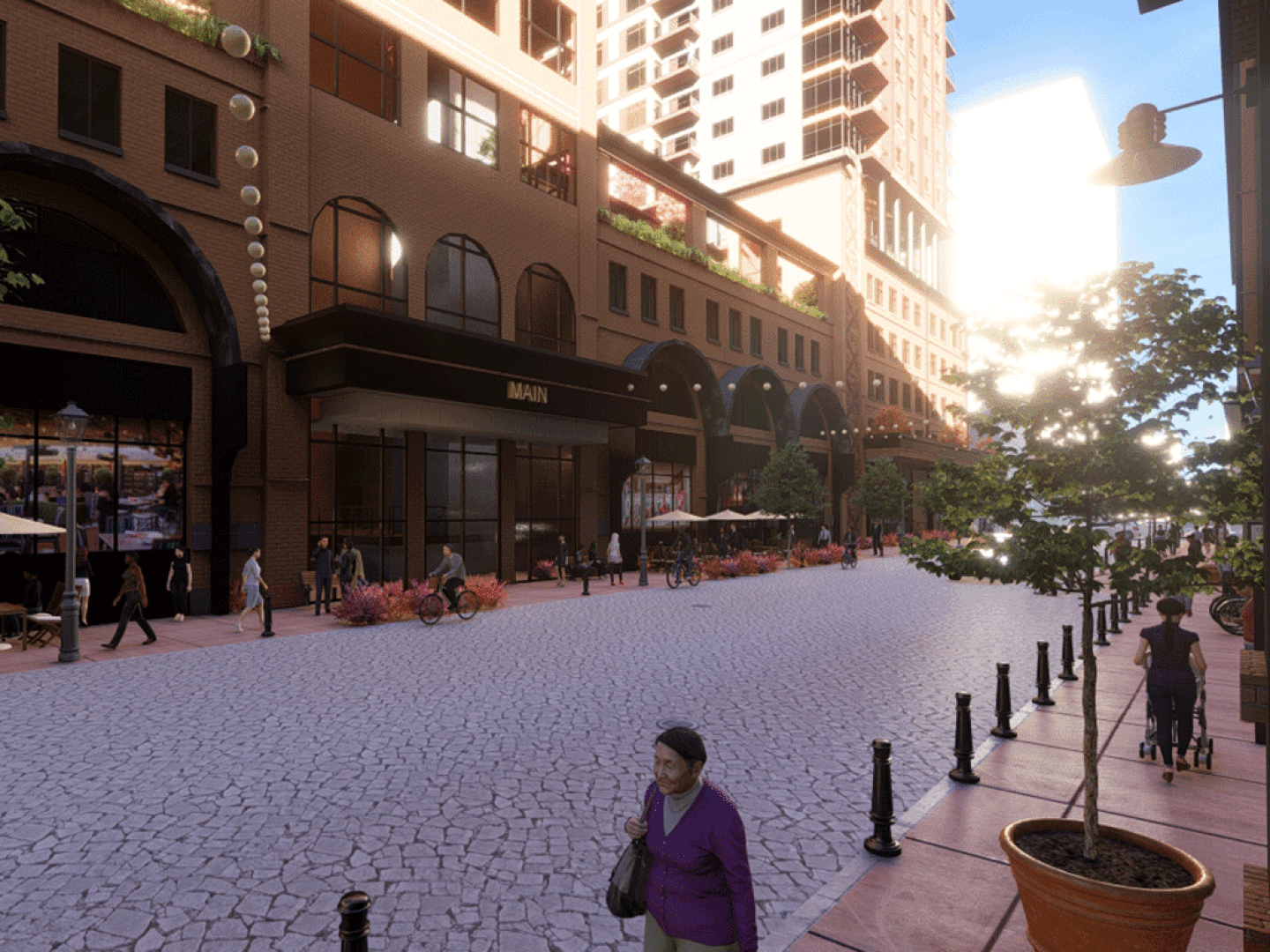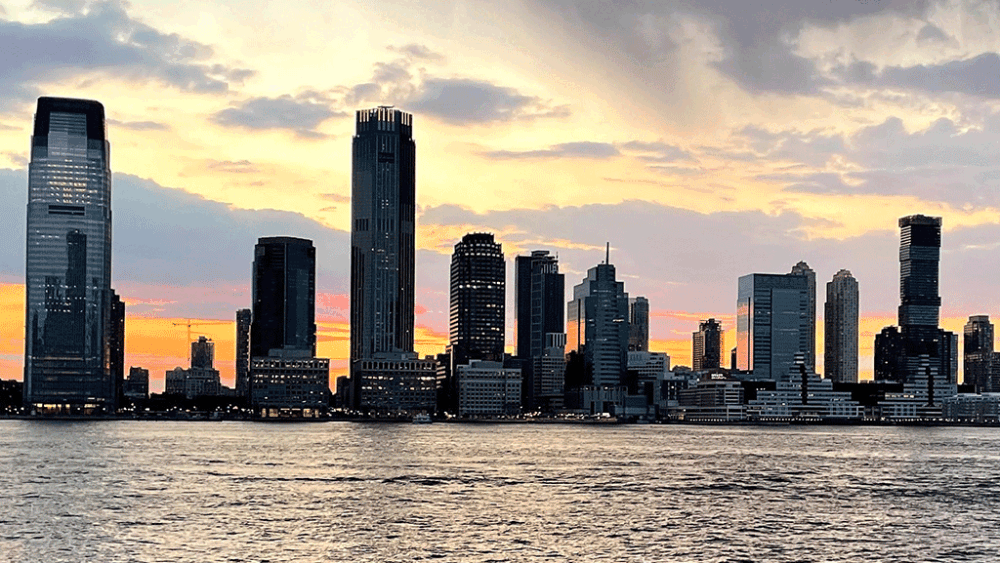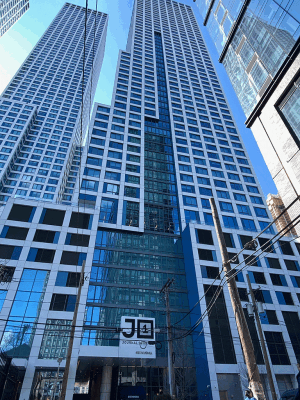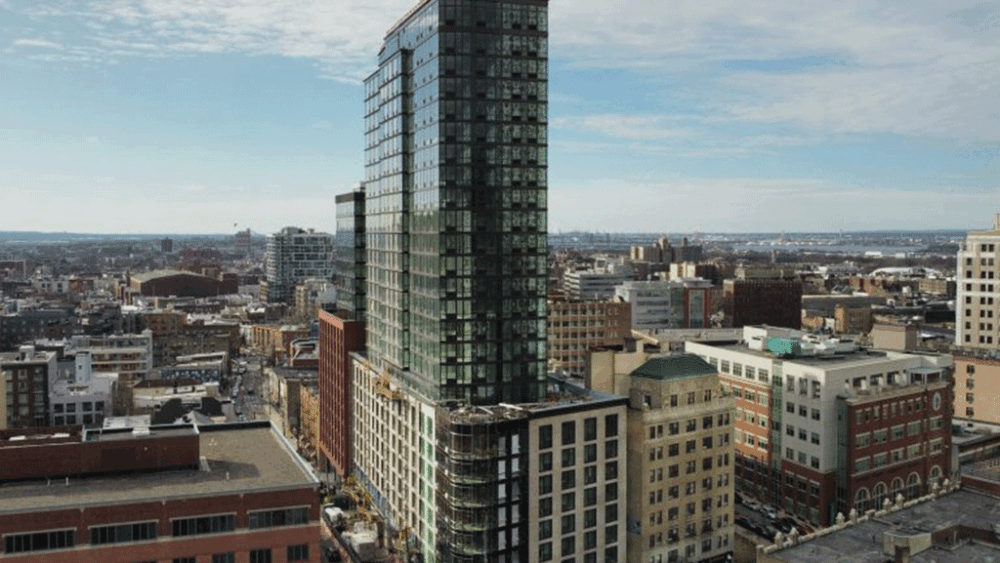New Yorkers have gotten used to watching the sun set behind the piers and towers of Jersey City, the major metropolis of New Jersey’s so-called Gold Coast. But for many years, Jersey City’s glittering line of luxury apartments and office blocks stopped at the water’s edge. Tucked behind modern high-rises, the rest of the city was a patchwork of charming historic districts, aging apartment buildings, public housing, and contaminated, abandoned industrial sites.
Planners and developers worked for years to draw commuters and investment beyond the waterfront. And based on a survey of current trends, it’s tempting to say: “Mission accomplished.” According to RealPage, the number of apartments in Jersey City is now growing more quickly than it is in any other submarket in the New York City area—and tenants are moving in to meet the growing inventory. Average rents are on the rise as new residents flock to live near Jersey City’s Arts District and its mass transit hub at Journal Square.
The shift took years of careful planning, the result of rezoning, property tax incentives, and civic investment, including in mass transit, public housing, and the arts. Jersey City’s boom has helped knit together the urban fabric of a community still tattered from decades of disinvestment and industrial decline.
A new city rises at Journal Square
In spring 2024, one of the tallest buildings in the State of New Jersey is scheduled to open in Journal Square, with 598 new apartments. The 60-story tower will be the last of three at Journal Squared, a megaproject developed by National Real Estate Advisors and Kushner Real Estate Group.
When it’s finished, Journal Squared will include 1,840 rental residences and 36,000 square feet (3,344.5 sq m) of retail and restaurant space arranged around a public plaza. The first two towers have already opened and are fully leased.
“It has been a massive success,” says Fahri Ozturk, senior vice president with CBRE, working in the firm’s offices in nearby Saddle Brook, adding that the towers “achieved higher rents than their pro forma estimates.”
The development is next door to the Journal Square Transit Center, which serves as a stop along Port Authority Trans-Hudson (PATH) commuter rail routes and a nexus of more than 20 bus lines. And it’s nearby the growing Journal Square Arts District, which includes the historic 3,000-seat Loew’s Jersey Theatre. Built in 1929, the theatre is currently being restored with a mix of private, city, state, and federal funds after operating in a limited capacity for decades.
The Kushner family is far from the only set of apartment investors active in Journal Square. Diego Hodara, founder and CEO of Titanium Realty Group, got his start in the area in the late 2000s by developing two-family houses. Back then, the streets around Journal Square were largely defined by aging, low-rise retail buildings. “I never had a doubt that this area would transform,” says Hodara.
Titanium opened 148 luxury apartments at 413 Summit Avenue in November 2023. Just four months later, according to Hodara, more than half (56 percent) have leased. In the spring of 2023, Titanium will add 386 new apartments at 425 Summit, part of a 25-story tower that topped out in July 2023.
High interest rates and construction costs over the last year kept many developers from starting new apartment projects across the U.S.—especially in high-cost markets like the towns around New York City.
That didn’t stop at least a few developers in Journal Square, where Titanium started construction on another 50 new apartments at 179 Academy Street in November 2023. Other participants in the ongoing boom include Panepinto Properties, which began building 605 new apartments in a 53-story tower at 499 Summit in September 2023. Namdar Group received a construction loan to build 576 apartments in a 27-story tower at 626 Newark Avenue, set to break ground in January 2024.
Jersey City absorbs thousands of new apartments
As of March 2024, according to RealPage, developers have more than 12,100 new apartments under construction in Jersey City. When finished, those apartments will increase the local inventory by a shocking 16 percent—enough to make Jersey City third out of 1,039 US submarkets ranked by RealPage in terms of growth. But despite increased inventory, rents in Jersey City grew a robust 4.6 percent. In comparison, apartment rents nationwide over the same period grew a paltry 0.3 percent on average.
New renters who have rushed to fill the new apartments opening in Jersey City enjoy easy access to New York City—Journal Square is just a 20-minute PATH ride to One World Trade Center in Lower Manhattan. And Jersey City shares some similarities with its sister city across the Hudson—15 of the 20 tallest buildings in the State of New Jersey are in Jersey City, mostly along the waterfront. By square foot, however, apartments in Jersey City are less expensive than similar apartments in New York. An average apartment in Jersey City rented for $3,700 in January 2024, according to RealPage. That’s nearly $1,500 less than a comparable apartment in New York City’s Financial District. A Jersey City apartment delivered since 2020 is about $500 a month less expensive on average than a class-B apartment in FiDi.
“A renter in Jersey City can choose to rent a brand new, state-of-the-art unit in Jersey City for a substantial discount,” says Carl Whitaker, a real estate economist with the data analytics division at RealPage.
Planning a development boom
Jersey City prepared the ground for the development now underway by carefully rezoning the blocks around Journal Square. “They up-zoned everything—your single-story retail building could be knocked down and you could build a 50-story tower,” says CBRE’s Ozturk. Until recently, Jersey City was also generous with its Payment in Lieu of Taxes (PILOT) program.
More recently, as building cranes crowd the skies over Jersey City, officials have been much less generous with PILOTs and property tax abatements, says Ozturk. Officials are also likely to ask developers who need a zoning variance about their plans to provide affordable housing.
Inventory poses another challenge to developers, who are finding it increasingly difficult to acquire land close enough to the Journal Square Transit Center to be attractive for development.
“Just four blocks away from the station, the rental pricing changes dramatically,” says Titanium’s Hodara. Projects developed further from Journal Square take in less income, but “the construction costs are the same.”
The streets around Journal Square also hold many older apartment buildings protected by Jersey City’s rent control laws. While landlords are allowed to renovate rent-controlled apartments as they become vacant and re-lease them at market rates, laws prevent developers from rapidly evicting tenants to demolish rent-controlled housing.
As development opportunities around Journal Square have tightened, city and state officials have laid the track for new development in more emerging neighborhoods. Especially attractive are communities with stops along the Hudson Bergen Light Rail line, which opened in 2000 and now runs along the Hudson waterfront from Union City in the north to Jersey City in the south. Officials are considering a proposed expansion.
“We have another site,” says Titanium’s Hodara. His firm is now seeking approval from city officials to build more than 400 new apartments in Jersey City. He did not disclose the exact location of the planned development except to say that the new apartments would be close to significant transit infrastructure.

The Jersey City Housing Authority (JCHA) and Winn Development partnered in 2023 to redevelop Holland Gardens, a public housing project first built in 1944. The redevelopment is planned to help Holland Gardens blend in better with its changing neighborhood on the border between Jersey City and Hoboken.
(PS&S Architects/Winn Development)
City partners to redevelop public housing
The Jersey City Housing Authority (JCHA) and Winn Development partnered in 2023 to redevelop Holland Gardens, a public housing project first built in 1944. The redevelopment is planned to help Holland Gardens blend in better with its changing neighborhood on the border between Jersey City and Hoboken. Tucked between a rail yard and busy streets that funnel cars in and out of the Holland Tunnel, the area surrounding Holland Gardens has been renamed “NoHo” by realtors and developers, which stand for “North of the Holland Tunnel.” Winn and the Housing Authority plan to replace the existing housing project’s 192 public housing apartments with a new residential tower containing the same number of public housing apartments in addition to 399 apartments renting at market rates. The development will include a new building with affordable apartments for seniors, a condominium building, and a community center that will include a new public library. Residents at Holland Gardens worried they would be forced to leave once the project was complete, but the Jersey City Council passed an ordinance that requires any redevelopment of Holland Gardens to give residents the right to return. Many of the new apartment towers that now surround Holland Gardens contain affordable housing, which city officials encouraged through offers of PILOTs and zoning variances to developers.
“The city responded to market-rate development happening with pretty appropriate and proactive zoning, which promoted more development,” says Dave Ginsberg, senior vice president of WinnDevelopment. “Then they undertook a pretty thoughtful process to find the highest and best use for a public housing site that’s respectful of the people and ultimately delivers a return to the Housing Authority—in the form of a ground lease payment.”
The JCHA has been working for years to redevelop public housing like Lafayette Gardens and Montgomery Gardens using HOPE VI grants from the federal Department of Housing and Urban Development. The new, mixed-use, mixed-income communities are now set in “Trending Hot” neighborhoods for development, according to the latest “Development Trends” report from local Grid Realty Brokers Advisor.
“If we didn’t revitalize those public housing projects it would be a completely different story,” says Jonathan Lubonski, managing vice president of development for the Michaels Organization. Lafayette Gardens and Montgomery Gardens both had significant problems with crime, said Lubonski.
Public/private partnership create Bayfront
Jersey City is now planning to create yet another new frontier for development—this time on the city’s western edge.
The Bayfront Redevelopment Project will redevelop a hundred-acre site on the shore of the Hackensack River, where workers previously spent years removing toxic contaminants. Developers Pennrose and Omni America will soon start work on the first phase of a new project that will eventually include 8,000 new residential units, 340,000 square feet (31,587 sq m) of commercial space, a new elementary school, a new waterfront walkway and a new light rail stop.
The development boom along New Jersey’s Gold Coast has shown no signs of slowing as developers get more creative and work on projects further inland. As inventory growth continues in newly revitalized neighborhoods, Jersey City and its neighboring communities will continue to attract renters in the New York area.








